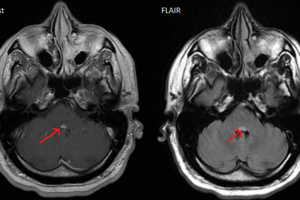Tolosa-Hunt Syndrome is a neuro-ophthalmologic diagnosis of exclusion that presents clinically as painful ophthalmoplegia with the ocular motor neuron palsies ipsilateral to the pain.
Presentation and Pathophysiology of Tolosa-Hunt Syndrome
The etiology of this syndrome is thought to be retro-orbital granulomatous inflammation. Because the three cranial nerves involved in eye movements (oculomotor nerve, trochlear nerve, abducens nerve) as well as the ophthalmic branch of the trigeminal nerve all exit the cranium through the superior orbital fissure, all can be involved when the area behind the eye is inflamed. In addition to CN 3-6 (V1 branch of 5), the maxillary branch of the trigeminal nerve (V2) runs in the cavernous sinus and can be affected when the inflammation extends back behind the superior orbital fissure.
The Miller-Fisher variant of Guillain-Barre Syndrome can share clinical features with Tolosa-Hunt Syndrome, but with Miller-Fisher Sydrome the patient usually has anti-GQ1b antibodies, which are not found with Tolosa-Hunt.
MRI findings for Tolosa-Hunt Syndrome
MRI findings include T1 post-gadolinium enhancement of the cavernous sinus on the affected side. The appearance of cavernous sinus enhancement is quite different from the retro-orbital inflammation seen with orbital pseudotumor. Importantly, because Tolosa-Hunt is a diagnosis of exclusion, MRI should be negative for other potential causes of pain and ophthalmoplegia like lymphoma or parasellar neoplasms, or suggestions of vasculitis (requiring angiography when suspicion is high).
{youtube}O5wkMJpDesU{/youtube}
Video: A 15-minute anatomy lecture on the cavernous sinus and middle fossa.
Treatment for Tolosa-Hunt
The pain of this disorder is quite responsive to steroids. In fact, one of the diagnostic features of Tolosa-Hunt Syndrome is that pain typically dissipates with 24 to 72 hours after starting corticosteroid therapy, with ophthalmoplegia typically improving more slowly. Of course many other disorders on the differential also improve with steroids so ruling out more serious causes of pain and ophthalmoplegia, like vasculitis, is important before diagnosing Tolosa-Hunt.
References
- Espay and Biller (2011) Concise Neurology
. Lippincott Williams & Wilkins; 1 edition (March 29, 2011)
- Danette C Taylor, DO, MS (2012) Tolosa-Hunt Syndrome, Medscape.com.
- Kenneth S Shindler, MD, PhD (2011) Tolosa-Hunt Syndrome, Uptodate.com.


